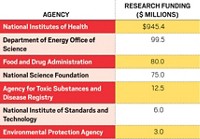Advertisement
Grab your lab coat. Let's get started
Welcome!
Welcome!
Create an account below to get 6 C&EN articles per month, receive newsletters and more - all free.
It seems this is your first time logging in online. Please enter the following information to continue.
As an ACS member you automatically get access to this site. All we need is few more details to create your reading experience.
Not you? Sign in with a different account.
Not you? Sign in with a different account.
ERROR 1
ERROR 1
ERROR 2
ERROR 2
ERROR 2
ERROR 2
ERROR 2
Password and Confirm password must match.
If you have an ACS member number, please enter it here so we can link this account to your membership. (optional)
ERROR 2
ACS values your privacy. By submitting your information, you are gaining access to C&EN and subscribing to our weekly newsletter. We use the information you provide to make your reading experience better, and we will never sell your data to third party members.
Policy
Biodefense Spending
U.S. is not spending enough on prevention, group says
by Lois Ember
June 18, 2007
| A version of this story appeared in
Volume 85, Issue 25

DESPITE SPENDING more than $40 billion on biological defense since the terror attacks of Sept. 11, 2001, the U.S. has allocated only $673 million to prevention efforts that are essential to improving national security, the Center for Arms Control & Non-Proliferation (CACNP) says in its latest analysis.
Spending to address the threat of bioweapons is now allocated among 11 federal departments and agencies. Such spending will approach nearly $50 billion if Congress fully funds the Bush Administration's fiscal 2008 request of nearly $7 billion.
Most of the biodefense money supports research, development, and acquisition of medical countermeasures and protective equipment. It also supports improvements in medical surveillance and detection of bioweapons, as well as preparedness at the state and local levels and in hospitals. Less than 2% of federal biodefense funding through fiscal 2007 has been allocated for prevention efforts. In fiscal 2008, however, the Pentagon aims to double spending on prevention efforts within its Cooperative Threat Reduction program to prevent states or terrorists from developing or acquiring bioweapons.
Alan Pearson, director of CACNP's Biological & Chemical Weapons Control Program, bemoans the government's meager prevention efforts. "The U.S. needs to devote more attention to preventing bioweapons from being used. This is the hardest thing to do, but it's cheaper than response and cleanup," he says.
The Department of Health & Human Services (HHS) receives the bulk of all biodefense dollars—$27.5 billion through fiscal 2008—with the National Institutes of Health garnering the largest share of the department's funding. A new program, the Biomedical Advanced Research & Development Authority, which was established in April, will receive nearly $1.1 billion through fiscal 2008. Some of that funding will be used to manage the procurement of medical countermeasures for chemical, biological, radiological, and nuclear agents.
On June 4, HHS announced a $500 million contract with Bavarian Nordic A/S for 20 million doses of a next-generation smallpox vaccine (C&EN, June 11, page 24). When manufactured, these doses will be stored in the Strategic National Stockpile, which is managed by the Centers for Disease Control & Prevention, for use in an emergency such as a bioterror attack.



Join the conversation
Contact the reporter
Submit a Letter to the Editor for publication
Engage with us on Twitter